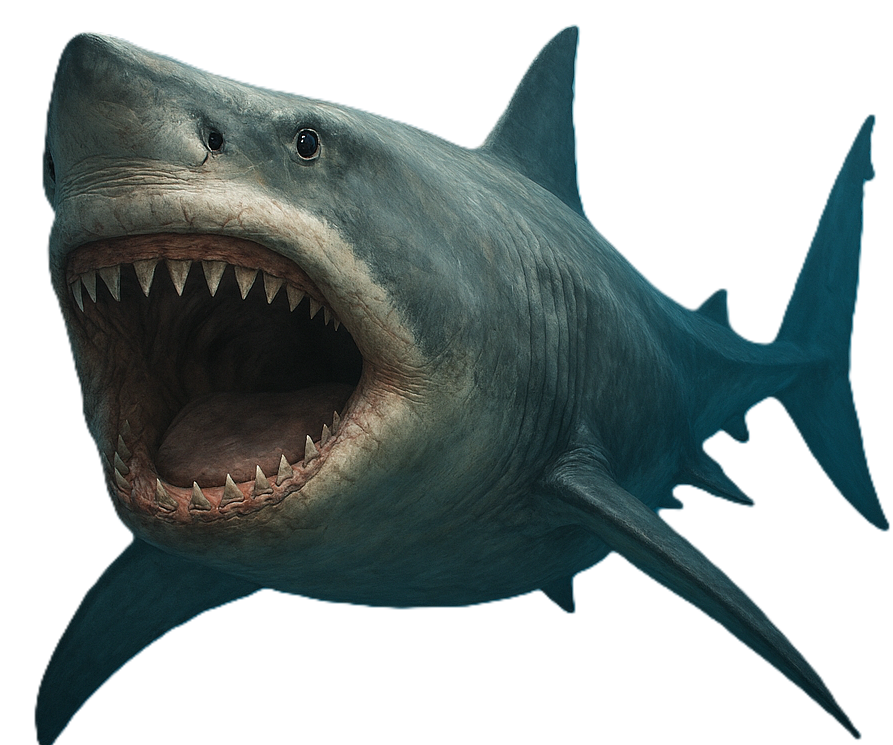
The name Megalodon derives from the Greek words megas (great) and odous (tooth), meaning “giant tooth.” This name is fitting, as Megalodon is primarily known from its massive fossilised teeth, some of which measure over 18 cm (7 inches) in length. First described by Swiss naturalist Louis Agassiz in 1835, Megalodon was once believed to be closely related to the modern great white shark, but recent studies suggest it belonged to a separate lineage within the extinct Otodontidae family.
Composition and Formation
Fossilised Megalodon teeth, vertebrae, and jaw fragments have been found across the world. Like all sharks, Megalodon had a cartilaginous skeleton, which rarely fossilised, making teeth the most common remains. These teeth, composed of calcium phosphate, have been preserved in marine sediments for millions of years, often turning shades of black, grey, or brown due to mineral absorption.
Locations and Distribution
Megalodon lived in warm oceans worldwide during the Miocene and Pliocene epochs, around 23 to 3.6 million years ago. Fossils have been discovered on every continent except Antarctica, with notable finds in North America, South America, Europe, Africa, and parts of Asia. Fossil-rich locations include coastal regions of the United States (Florida, California, and the Carolinas), Peru, Japan, and Morocco.
Physical Characteristics
- Size: Estimated to reach 15–20 metres (50–65 feet) in length, making it one of the largest predators in Earth’s history.
- Weight: Between 50 and 100 tonnes, significantly larger than modern great white sharks.
- Teeth: Serrated, triangular teeth designed for crushing bones and slicing through thick prey.
- Jaw Power: One of the strongest bites in history, capable of exerting over 40,000 pounds of force.
- Diet: Fed on large marine animals, including whales, dolphins, sea turtles, and other sharks.
- Swimming Ability: Likely a powerful swimmer, capable of high-speed ambush attacks.
Archaeological Finds and Historical Usage
Megalodon teeth have been collected for centuries, sometimes mistaken for dragon tongues or petrified lightning bolts in medieval Europe. These fossils were ground into powder and used in traditional medicine. Indigenous cultures in the Americas and Africa often saw Megalodon teeth as sacred relics, believing they held protective or mystical properties.
Interesting Facts
- A single Megalodon could lose and replace thousands of teeth over its lifetime.
- Some scientists believe its extinction was due to climate change and the decline of large prey species.
- Modern great white sharks, although formidable, are dwarfed by the sheer size of Megalodon.
- The largest Megalodon tooth ever found measures over 19 cm (7.5 inches).
- Some legends claim Megalodon still roams the deep oceans, but no scientific evidence supports this idea.
Folklore, Legends and Tales
Stories of giant sea monsters persist across cultures, often linked to Megalodon. Sailors feared monstrous sharks capable of swallowing ships whole, and some cryptid enthusiasts believe it still exists in the unexplored depths of the ocean. Indigenous myths from the Pacific describe massive sharks as divine beings or ocean guardians, sometimes punishing those who disrespected the sea.
Links with Astrology and the Chakra System
Astrologically, Megalodon resonates with Scorpio due to its dominance, mystery, and connection to deep waters. Scorpio, ruled by Pluto, symbolises transformation and power—qualities embodied by this ancient predator.
In the chakra system, Megalodon is closely linked to the root chakra (Muladhara), representing survival, strength, and primal instincts. Its presence in ancient waters suggests a connection to the throat chakra (Vishuddha), symbolising communication and the mysteries of the ocean’s depths.

Megalodon
Megalodon products
